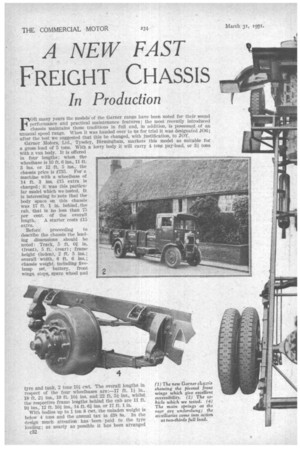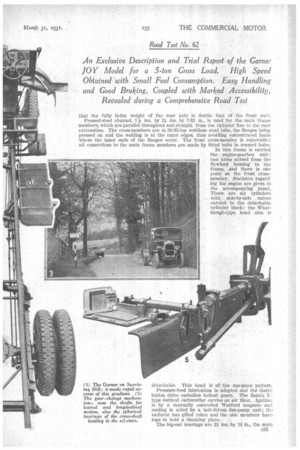• A NEW FAST FREIGHT CHASSIS
Page 54

Page 55

Page 56

Page 57

If you've noticed an error in this article please click here to report it so we can fix it.
In Production
FOR many years the models'of the Garner range have been noted for their sound performance and practical maintenance features; the most recently introduced chassis maintains these traditions in full and, in addition, is possessed of an unusual speed range. When it was handed over to us for trial it was designated J06; after the test we suggested that this be changed, with justification, to JOY.
Garner Motors, Ltd., Tyseley, Birmingham, markets this model as suitable for a gross load of 5 tons. With a lorry body it will carry 4 tons pay-load, or 31 tons with a van body. It is offered in four lengths ; when the wheelbase is 10 ft. 6 ins., 11 ft. 3 ins. or 12 ft. 5 ins., the chassis price is £735. For a machine with a wheelbase of 14 ft. 3 ins. £15 extra is charged ; it was this particular mixlel which we tested. It is interesting to note that the body space on this chassis was 17 ft. 1 in. behind_the cab, that is no less than 75 per cent. of the overall length. A starter costs £15 extra.
Before proceeding to describe the chassis the leading dimensions should be noted: Track, 5 ft. 01 in. (front), 5 ft. (rear) ; frame height (laden), 2 ft. 5 ins.; overall width, 6 ft. 6 . ins.; chassis weight, including five,. lamp set, • battery, front wings, steps, spare wheel and
tyre and tank, 2 tons 101 cwt. The overall lengths in respect of the four wheelbases are :-17 ft. 11 in., 18 ft. 21 ins., 19 ft. 101 ins. and 22 ft. 51 ins., whilst the respective frame lengths behind the cab are 11 ft. 9i ins., 12 ft. 101 ins., 14 ft. 61 ins. or 17 ft. 1 in. With bodies up to 1 ton 8 cwt. the unladen weight is below 4 tons and the annual tax is 138 8s. In the design much attention has been paid to the tyre loading; as nearly as possible it has been arranged c32 that the fully laden weight of the rear axle is double that of the front axl.7!..
Pressed-steel channel, 7A ins. by 2f ins. by 7-32 in., is used for the main frame members, which are parallel throughout and straight from the radiator line to the rear extremities. The cross-members are in 30-35-ton weldless steel tube, the flanges being pressed on and the welding is at the outer edges, thus avoiding concentrated loads where the inner ends of the flanges occur. The front cross-member is removable; all connections to the main frame members are made by fitted bolts in reamed holes.
In this frame is carried the engine-gearbox unit ; two arms extend from the flywheel housing to the frame, and there is one point on the front crossmember. Statistics regarding the engine are given hi the acCompanyingPanel. There are six cylinders with side-by-side valves carried in the detachable cylinder block ; the Whatmough-type head also is
detachable. This head Is of the one-piece pattern.
Pressure-feed lubrication is adopted and the distribution drive embodies helical gears. The Zenith type vertical carburetter carries an air filter. Ignition is by a manually controlled Watford magneto and cooling is aided by a belt-driven fan-pump unit; the radiator has gilled tubes and the side members have lugs to hold a blanking plate.
The big-end bearings are 2i ins, by 1 in., the main e..33 bearings are 2i ins. by 2i ins, and the camshaft runs in 24n. by 1-1-in. bearings. Nine coil springs are employed in the toggleoperated, single-plate, dry, 13/-in. clutch ; the withdrawal bearing is of the ball type. Bolted to the bell housing of the clutch is the four-speed-and-reverse gearbox. Removal of the cover discloses a full-width opening, a 2-in. mainshaft, layshaft and I-in. wide gearwheels, which, like the shafts, are made in 3 per cent, case-hardening nickel-steel. The teeth have a 20-degree pressure angle and the third-speed and constant-mesh wheels are ground. When not in use the reverse pinion is idle. Take-offs are provided for the speedometer drive and mechanical tyre pump, which are both standard equipment. A two-piece propeller shaft, with a self-aligning steady bearing, takes the drive to the overhead worm axle; the shafts are fully floating and the David Brown worm and wheel give a ratio of 6.5 to 1; 6 to 1 or, 7 to .1 are optional ratios. The 17-in. rear-wheel drums house pairs of shoes, side by side; the facings are 3 ins. wide. The pedal operates one set through a Marcia servo; the hand lever controls the other set mechanically. Spherical bearings are used for the cross-shafts; the rods are in: in diameter. A rebound leaf is used for each front spring, and the . rear underslung semi-elliptics are aided by auxiliaries carried above the axle ; these come into operation at two-thirds full load. The cam-and-roller steering box operates a spring-loaded drag link. The usual ,instruments are conveniently grouped on an aluminium facia directly above the steering column. On the chassis is an angle-steel sub-frame to carry e34 the cab ; it also forms the base of the seats and, after their removal, instant access can be had to the gearbox. By an original method, adopted for many years on 'Garner models, the cab door, front wing, valance and part of the floor on each side can be swung aside, giving room for, the mechanic to get{ closer to the engine than is possible with the standard normalcontrol machine.
The short bonnet in front of the dash gives access to the oil filler, pump gland and fan belt. Greatkare has been taken to make the engine, clutch, gearbox and rear axle really get-at-able when the body is in position—the latter point is sometimes overlooked.
Standard electric equipment is of the 12-volt, fivelamp type; an electric horn is supplied and the battery has a capacity of 51 ampere-hours.
Turning now to the road performance of this new Garner; our expectations, in view of the high power-toweight ratio, were fully realized. After a preliminary inspection the ,ballast-laden chassis was weighed ;fthe results are embodied in the panel. The gross weight was representative of service conditions. The particular chassis had covered some 17,006 miles. During the first few miles out of Birmingham we had ample opportunity for testing the flexibility; from 3 m.p.h. to 52 m.p.h. without a gear change is rather an unusual range for a goods chasSis. The drive was free from any sign of harshness, and there was no engine vibration except a trace when doing 59 m.p.h. downhill—that is, far beyond the peak of the power curve.
Owing to the sweetness of the .engine and transmission40 m.p.h. is a comfortable cruising speed. The cab evinced no drumming or sympathetic vibration, and its construction gave a wide range of vision. When seated behind the wheel we found that the disposition of The controls gave a natural and restful position. The steering was one of the lightest we have tried, and the castor action was sufficient to straighten up automatically after a bend, but not too much, so as to demand a further action by the -, driver ; we drove "hands off at over 50 m.p.h. -• • ' • • Except for the climb of Sunrising Hill (1 in. 6) and after traffic baulks we used-n6thing but top gear. Long hills were climbed steadily at cat, speeds, a stretch of 1 in 11 being breasted at 32 M.p.h., If desired the engine -would " on inclines on the 6.5. to -1 gear at speeds well below the legal linfit. Second gear spfficed on Sunrising so far as the hair-pin corner ; a stop-and-restart test on the follow• inggradient -was .easy and the take-up smooth. After this, climb it was found that the water in the radiator had risen in temperature from 172 .degrees F. to 201 degrees, therefore the, cooling capacity is adequate.
Upward and downward changes Were effected with ease by the employment of conventional methods, and
the judgment of shaft speeds ,did not call for finesse. The clutch was light in operation and in all circumstances _ acted without fierceness or slip; The specific 'braking tests proved that good twowheel braking can be as efficient as many four-wheel braking systems. The servo was so light in action that the laden velicle was brought to rest from 40 m.p.h. simply by pressure of the .right hand upon the pedal. The braking effort could at all times be felt through the pedal and without the servothe operating mechanism functioned properly.
As the acceleration graphs show, the performance was superior to that of some coach cliassis=a high tribute in these days. The gear ratios were well graded and the axle ratio of 6.5 to 1 suited the engine admirably. We expected the fuel consumptioa to suffer somewhat in the light of the generous speed capabilities. When the results were worked out the return proved to be 10.7 m.p.g. on measured quantities of fuel—a gratifying figure. The carburetter setting during all tests was the same-110 main jet, 195 com pensating jet and 27 choke. The oil consumption return is stated to be at least 2,750 m.p.g.
• Summarizing the-foregoing it will be realized that the Garner JOY
model proved satisfactory in every way in regard to weight distribution, flexibility, ease of handling, acceleration and braking and fuel consumption. Its speed capabilities were much above the average for a machine of its load capacity. Its accessibility was up to the standard which has long been associated with Garner vehicles.
Evidence of this accessibility is shown in the engine-gearbox unit. The bell housing for the clutch is bolted to the end of the crankcase, at the forward end, and to the gearbox at the rear ; thus it is possible to remove only the gearbox or the gearbox and clutch without touching the engine. To permit this the propeller shaft may be dropped; this entails merely disconnection of the 'universal joint behind the gearbox and uncoupling the bolts which carry the thousing of the steady bearing. • • Owing to the employment of a fully floating type of rear axle it is possible to remove the -complete
• Worm and wheel, with differential, without detachment • of the *road wheels or. the need for jacking up the axle. This obviates the need fer the removal of any load which may be in the body at the time.
• Another example of good detail design is in connection • with the rear-wheel brakes; ample clearance has been allowed between the inside of the rims and the outside of the drums to provide cooling.












































































































